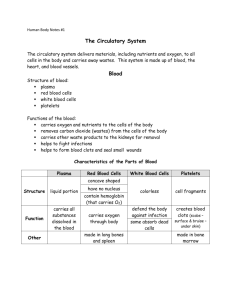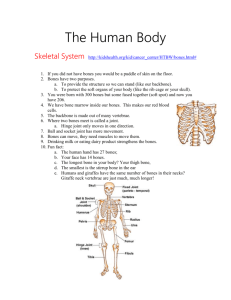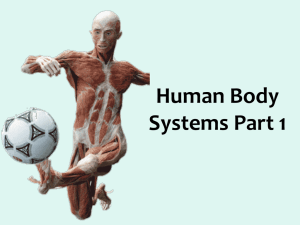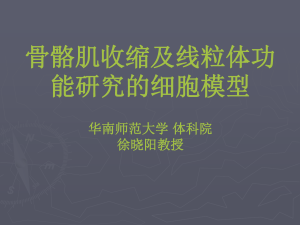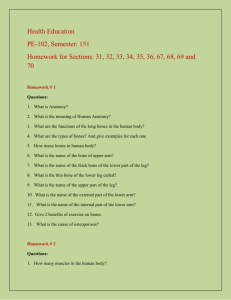Body Systems
advertisement
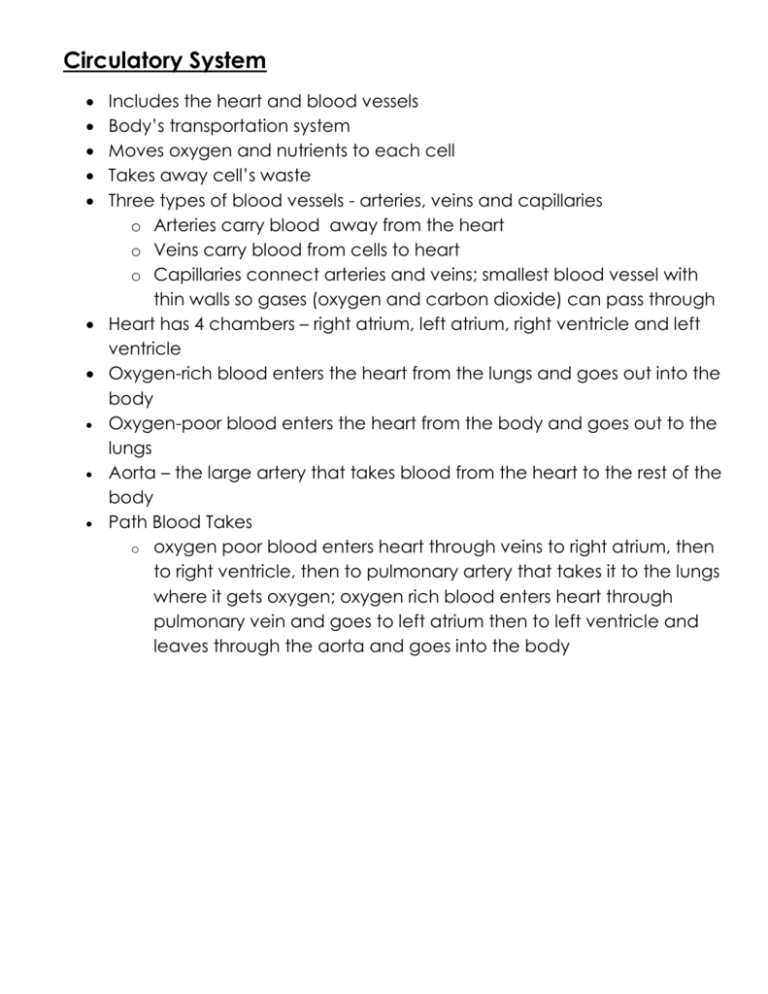
Circulatory System Includes the heart and blood vessels Body’s transportation system Moves oxygen and nutrients to each cell Takes away cell’s waste Three types of blood vessels - arteries, veins and capillaries o Arteries carry blood away from the heart o Veins carry blood from cells to heart o Capillaries connect arteries and veins; smallest blood vessel with thin walls so gases (oxygen and carbon dioxide) can pass through Heart has 4 chambers – right atrium, left atrium, right ventricle and left ventricle Oxygen-rich blood enters the heart from the lungs and goes out into the body Oxygen-poor blood enters the heart from the body and goes out to the lungs Aorta – the large artery that takes blood from the heart to the rest of the body Path Blood Takes o oxygen poor blood enters heart through veins to right atrium, then to right ventricle, then to pulmonary artery that takes it to the lungs where it gets oxygen; oxygen rich blood enters heart through pulmonary vein and goes to left atrium then to left ventricle and leaves through the aorta and goes into the body Respiratory System respiratory system takes in oxygen from the air that you breathe. air travels down throat and passes through your trachea (or windpipe). Trachea leads to two branches called bronchi that go into the lungs. bronchi (bronchus) let air in and out of your lungs so you can breathe bronchi branch into smaller tubes called bronchioles bronchioles end in clusters of tiny thin-walled alveoli, or air sacs, in the lungs - oxygen enters the blood and carbon dioxide leaves the blood. when you breathe out, carbon dioxide leaves your body Your diaphragm is dome-shaped muscle below the lungs. It tightens and relaxes to make you breathe in and breathe out Digestive System Digestion is the process by which food and drink are broken down into their smallest parts so the body can use them to build and nourish cells and to provide energy Direction food goes: mouth – esophagus – stomach – small intestine – large intestine Digestion begins in your mouth when you chew Muscles contract in waves to move the food down the esophagus. This means that food would get to a person’s stomach even if they were standing on their head. In the stomach, the food is mixed with chemicals that help break it down. (An adult’s stomach can hold about 1.5 liters of material) Next, food goes to the small intestine where more chemicals continue to break down food o three organs help the small intestine gather the nutrients: pancreas, liver, gall bladder In the large intestine, water is removed from food and taken into the body. Any remaining food that has not been digested becomes waste. Nervous System made up of the brain, spinal cord and nerves controls all the actions of the body two main parts of the nervous system o Central Nervous System brain and spinal cord brain has three parts cerebrum - largest part of the brain that controls senses, thought and imagination cerebellum – little brain; helps us move and learn new things; coordinates skeletal muscles brain stem and medulla – work as a team; connected to spinal cord; control things like our heartbeat, breathing, blood pressure and digestive system o Peripheral Nervous System delivers messages from the central nervous system to the rest of the body neurons transmit messages throughout the body neurons have three parts o cell body - core o dendrites - take in the electrical impulses to the cell body (dendrites = doorway) o axon – carry the impulse away from the cell body (axons = exit) Two types of nerves o central nerves – carry information to the central nervous system o motor nerves – carry information from the central nervous system to other parts of the body Muscular System voluntary muscles – muscles that can be controlled with the mind involuntary muscles – These don’t need the brain to send them messages. You can’t control them. Three types of muscles: Smooth Muscles – involuntary muscle that are in sheets or layers with one layer of muscle behind the other. o Examples - Your stomach muscles work to digest your food. The muscles in your eyes keep the eyes focused. The muscles at the bottom of the hairs on your arms will make your hairs stand up when you are cold. Cardiac Muscle – heart – works to pump blood throughout your body. Your heart is an involuntary muscle. Skeletal Muscles – voluntary muscles that help you kick a ball, left a pencil, etc. Skeletal System Skeletal system is made up of bones, ligaments and tendons Adult has 206 bones. Babies are born with about 300 bones. Their bones fuse (grow together) as you get older. Jobs of the skeletal system o supports the body o helps you move o stores calcium and other minerals until the body needs them o protects internal organs skull protects brain ribs protect heart and lungs o produces blood cells – made by bone marrow which is found at the center of the bone Joints hold your bones together and allow them to move o ball and socket – allow for lots of movement in every direction (example – shoulder and hips) o hinge – allows forward or backward motion (example – elbows, knees) o gliding – one bone slides over enough (example is write or ankle) Tendons – fibrous tissue that connect muscles to bones so the bones can move Ligaments – connect bone to bone and help to stabilize the joints they surround. o A knee joint with the ligaments shown in pink.



